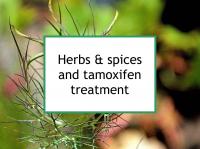The current webpage is designed to make additional research available concerning how certain herbs and spices or their major bioactive components can enhance the treatment effects of tamoxifen. At the bottom of this webpage are links to studies relating to the beneficial herbs and spices listed in Foods to eat and avoid during tamoxifen treatment.
Generally speaking, herbs and spices increase the treatment effects of tamoxifen, or counteract its side effects (without reducing its efficacy), primarily through the actions of certain polyphenols, among them:
- Apigenin (found, for example, in celery seed, Mexican oregano, parsley)
- Beta-carotene (basil, cilantro, parsley)
- Carvacrol (black cumin, Mexican oregano, oregano)
- Curcumin (turmeric)
- I3C & DIM (horseradish & wasabi, mustard)
- Kaempferol (saffron)
- Lutein (basil, cilantro, parsley)
- Luteolin (celery seed, oregano, thyme)
- Myricetin (parsley)
- Piperine (black pepper)
- Quercetin (chili powder, hot sauce, Mexican oregano)
- Sulforaphane (horseradish & wasabi, mustard)
- Thymoquinone (black cumin)
- Ursolic acid (basil, rosemary, thyme)
Please read the applicable food webpages when making your own food lists since these pages contain important advice, food rankings (e.g., highly recommended, recommended in moderation), consumption limits, and other pertinent information.
Herbs and spice compounds should be obtained by eating herbs and spices rather than taking supplements. When a beneficial micronutrient is administered at low doses by consuming food, it is likely to have subtle chemopreventive effects, whereas the same compound administered at high doses is more likely to have pharmacological effects, with possible unwanted outcomes. For example, quercetin has been reported to contribute to the growth of estrogen-induced mammary tumors once the tumors were established in female rats.
